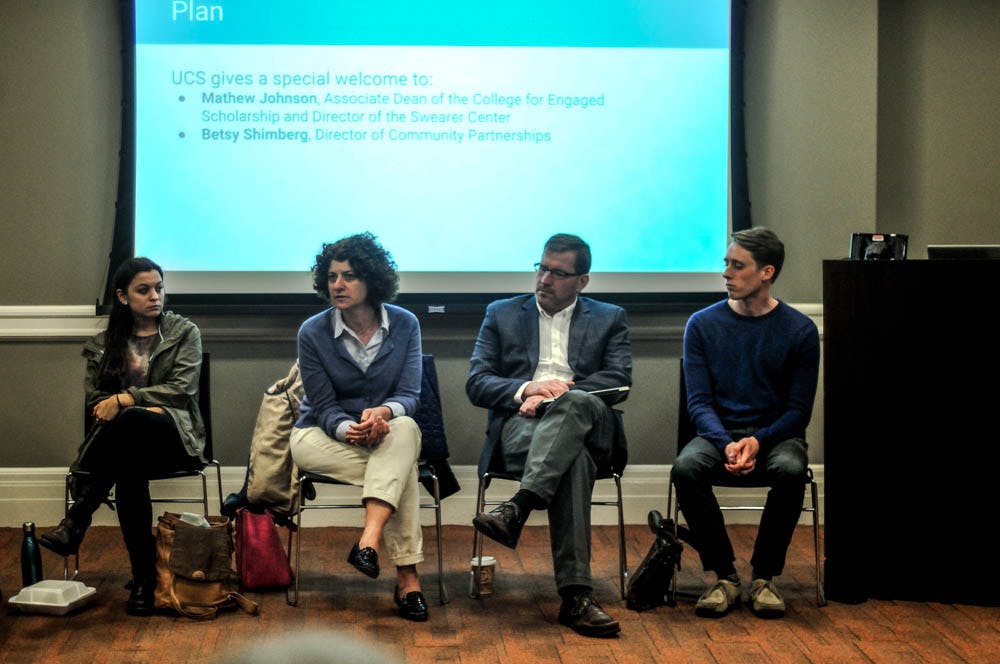Swearer Center for Public Service staff members detailed new initiatives designed to integrate community service work into the University curriculum in a presentation of a draft of its strategic plan to the Undergraduate Council of Students at its general body meeting Wednesday.
Swearer Center Director and Associate Dean for Engaged Scholarship Mathew Johnson and Director for Community Partnerships Betsy Shimberg highlighted the implementation of the new Bonner Community Fellows program, which will serve as an opportunity for low-income and first-generation students to become involved in the Center’s work.
The Bonner Fellows program is designed as “the highest level of community engagement fellowship,” according to the strategic plan draft. Fellows will serve as “team and project leaders, teaching assistants to community-engaged courses, community liaisons and community engagement workshop facilitators,” the draft stated. They will also have the opportunity to attend trainings outside their own programs and move between programs, Johnson said.
The Bonner fellowships will gradually replace the old Community Fellows program that currently funds 35 students. The program base is scheduled to grow to over 160 funded leadership positions over the next five years, Johnson said.
Transitioning from the Community Fellows model to the Bonner model will be a gradual process, Johnson said. “No one who is currently a fellow will lose their job,” he added. The number will be reduced from 35 to 29 next year, with the recruited Bonner Fellows filling the gap.
The new model more closely matches the University’s open-minded philosophy, Shimberg said. In order to assume a leadership position in the current model, a student would have to volunteer in a program for several years, which is sometimes not possible for lower-income students. “We’re excluding those who have work-study responsibilities” under the current system, Shimberg added.
The program is designed as a four-year initiative, with an application process for incoming freshmen, Johnson said. “Research at other institutions shows that the four-year model increases retention, academic success and the four-year graduation rate,” he added.
About 75 percent of the students in the program will be first-generation or low-income, he added.
Another component of the plan is increased collaboration among different programs within the Swearer Center. “We want everyone working with Swearer to think of themselves as a ‘Swearer person,’” Johnson said. “We see opportunities for collaboration that aren’t happening right now.”
Swearer is also looking at expansion, both in terms of its number of sponsored programs and the physical space allotted for its work. The University is currently in the midst of a space analysis, Johnson said. “We’re busting at the seams,” he added. “Not only do we need more space, but we need better space.”
“Another issue with our space is that it isn’t accessible,” Shimberg added. For example, “There’s no place for our community partners to park.”
Johnson and Shimberg both expressed optimism about Swearer’s funding and its capacity to grow its outreach. Out of the $3 billion BrownTogether capital campaign, $50 million are to be reserved for the Swearer Center, Johnson said. “We’re one of the top 10 priorities in the capital campaign,” he added.
UCS also categorized 17 student groups during its general body meeting. Tirra-Lyra Troupe, Society of Hispanic Professional Engineers Brown University Student Chapter, Kofán Brown Student Alliance, Brown Theatre Collective, Girl Up, Benevolent Records, Brown University Chapter of Students for the Exploration and Development of Space, SafeDuck and Brown Immigrant Rights Coalition were categorized as Group I; B-Side and Lean In were categorized as Group II; Iranian Student Association, Mariachi de Brown, Disney A Cappella and Quiz Bowl were categorized as Group III; and Brown Students Against Gun Violence and 180 Degrees at Brown University were categorized as Group S.





